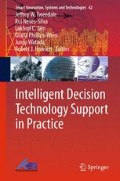Abstract
The radial basis function neural network trained with a dynamic decay adjustment (known as RBFNDDA) algorithm exhibits a greedy insertion behavior as a result of recruiting many hidden nodes for encoding information during its training process. In this chapter, a new variant RBFNDDA is proposed to rectify such deficiency. Specifically, the hidden nodes of RBFNDDA are re-organized through the supervised Fuzzy ARTMAP (FAM) classifier, and the parameters of these nodes are adapted using the Harmonic Means (HM) algorithm. The performance of the proposed model is evaluated empirically using three benchmark data sets. The results indicate that the proposed model is able to produce a compact network structure and, at the same time, to provide high classification performances.
Access this chapter
Tax calculation will be finalised at checkout
Purchases are for personal use only
References
Bache, K., Lichman, M.: UCI Machine Learning Repository [http://archive.ics.uci.edu/ml]. University of California, School of Information and Computer Science, Irvine (2013)
Berthold, M.R., Diamond, J.: Constructive training of probabilistic neural networks. Neurocomputing 19(1–3), 167–183 (1998)
Bortman, M., Aladjem, M.: A growing and pruning method for radial basis function networks. IEEE Trans. Neural Netw. 20(6), 1039–1045 (2009)
Carpenter, G.A., Grossberg, S., Markuzon, N., Reynolds, J.H., Rosen, D.B.: Fuzzy artmap: a neural network architecture for incremental supervised learning of analog multidimensional maps. IEEE Trans. Neural Netw. 3(5), 698–713 (1992)
Carpenter, G.A., Milenova, B.L., Noeske, B.W.: Distributed artmap: a neural network for fast distributed supervised learning. Neural Netw. 11(5), 793–813 (1998)
Dogantekin, E., Dogantekin, A., Avci, D.: An automatic diagnosis system based on thyroid gland: ADSTG. Expert Syst. Appl. 37(9), 6368–6372 (2010)
Efron, B.: Bootstrap methods: another look at the jackknife. Ann. Stat. 7(1), 1–26 (1979)
Fernández-Navarro, F., Hervás-Martínez, C., Gutiérrez, P.A., Peña-Barragán, J.M., López-Granados, F.: Parameter estimation of \(q\)-gaussian radial basis functions neural networks with a hybrid algorithm for binary classification. Neurocomputing 75(1), 123–134 (2012)
Han, H.-G., Qiao, J.-F.: A structure optimisation algorithm for feedforward neural network construction. Neurocomputing 99, 347–357 (2013)
Hudak, M.H.: RCE classifiers: theory and practice. Cybern. Syst. 23(5), 483–515 (1992)
Keleş, A., Keleş, A.: Expert system for thyroid disease diagnosis. Expert Syst. Appl. 34(1), 242–246 (2008)
Kohavi, R.: A study of cross validation and bootstrap for accuracy estimation and model selection. In: Proceedings of the 14th International Joint Conference Artificial Intelligence (IJCAI), pp. 1137–1145. Morgan Kaufmann (1995)
Martínez-Rego, D., Pérez-Sánchez, B., Fontenla-Romero, O., Alonso-Betanzos, A.: A robust incremental learning method for non-stationary environments. Neurocomputing 74(11), 1800–1808 (2011)
Ni, J., Song, Q.: Dynamic pruning algorithm for multilayer perceptron based neural control systems. Neurocomputing 69(16–18), 2097–2111 (2006)
Paetz, J.: Reducing the number of neurons in radial basis function networks with dynamic decay adjustment. Neurocomputing 62, 79–91 (2004)
Polat, K., Gunes, S.: An expert system approach based on principal component analysis and adaptive neuro-fuzzy inference system to diagnosis of diabetes disease. Digit. Signal Proc. 17(4), 702–710 (2007)
Reed, R.: Pruning algorithms—a survey. IEEE Trans. Neural Netw. 4(5), 740–747 (1993)
Reilly, D.L., Cooper, L.N., Elbaum, C.: A neural model for category learning. Biol. Cybern. 45(1), 35–41 (1982)
Specht, D.F.: Probabilistic neural networks. Neural Netw. 3(1), 109–118 (1990)
Widrow, B., Greenblatt, A., Kim, Y., Park, D.: The no-prop algorithm: a new learning algorithm for multilayer neural networks. Neural Netw. 37, 182–188 (2013)
Xu, R., Wunsch II, D.C.: BARTMAP: a viable structure for biclustering. Neural Netw. 24(7), 709–716 (2011)
Yang, S.-H., Chen, Y.-P.: An evolutionary constructive and pruning algorithm for artificial neural networks and its prediction applications. Neurocomputing 86, 140–149 (2012)
Yang, L., Yang, S., Zhang, R., Jin, H.: Sparse least square support vector machine via coupled compressive pruning. Neurocomputing 131, 77–86 (2014)
Zhang, B.: Generalized k-harmonic mean—boosting in unsupervised learning. Technical Report HPL-2000-137, Hewlett-Packard Laboratories (2000)
Author information
Authors and Affiliations
Corresponding author
Editor information
Editors and Affiliations
Rights and permissions
Copyright information
© 2016 Springer International Publishing Switzerland
About this chapter
Cite this chapter
Tan, S.C., Lim, C.P., Watada, J. (2016). A Parsimonious Radial Basis Function-Based Neural Network for Data Classification. In: Tweedale, J., Neves-Silva, R., Jain, L., Phillips-Wren, G., Watada, J., Howlett, R. (eds) Intelligent Decision Technology Support in Practice. Smart Innovation, Systems and Technologies, vol 42. Springer, Cham. https://doi.org/10.1007/978-3-319-21209-8_4
Download citation
DOI: https://doi.org/10.1007/978-3-319-21209-8_4
Published:
Publisher Name: Springer, Cham
Print ISBN: 978-3-319-21208-1
Online ISBN: 978-3-319-21209-8
eBook Packages: EngineeringEngineering (R0)

